Aspects of Contract Law Report
VerifiedAdded on 2019/12/03
|10
|2693
|250
Report
AI Summary
This report delves into aspects of contract law and tort law, analyzing scenarios to illustrate key concepts. Scenario 1 examines the essential elements of a valid contract (offer, acceptance, consideration, intention), categorizes contracts (written/verbal, distant/face-to-face), and analyzes a case involving Gastropubs and Xs Ltd, focusing on expressed and implied terms, and the Unfair Contract Terms Act 1977. Scenario 2 differentiates contractual obligation from tort liability, outlining the elements of negligence (duty of care, breach of duty, remote damages, foreseeability) and applying these to cases involving Fiona's injury and Bob's workplace accident. The concept of vicarious liability is also explored through a case involving Jason's delivery accident. The report concludes by summarizing the legal implications of the discussed scenarios and enhancing theoretical knowledge of contract and tort law.
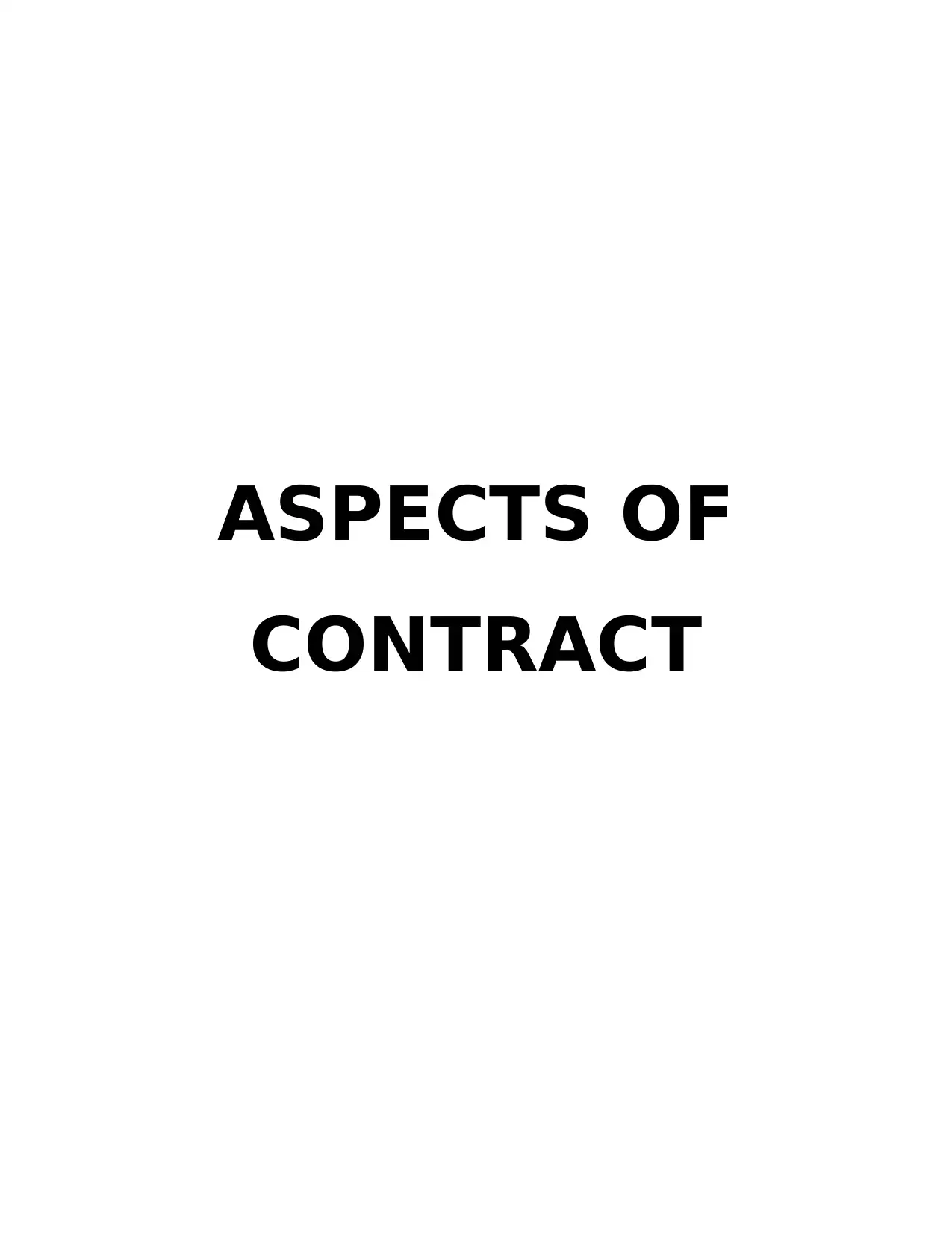
ASPECTS OF
CONTRACT
CONTRACT
Paraphrase This Document
Need a fresh take? Get an instant paraphrase of this document with our AI Paraphraser
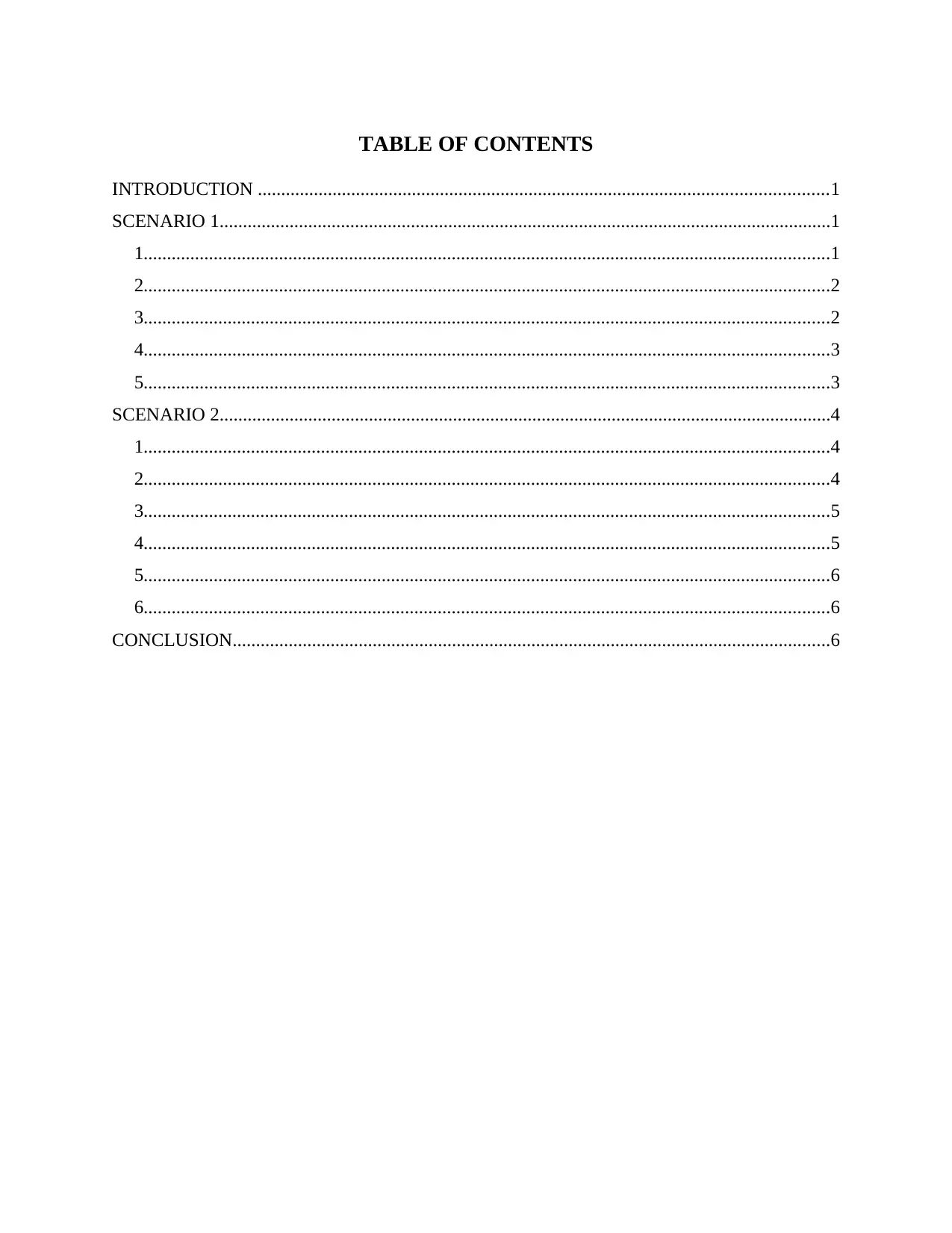
TABLE OF CONTENTS
INTRODUCTION ..........................................................................................................................1
SCENARIO 1...................................................................................................................................1
1...................................................................................................................................................1
2...................................................................................................................................................2
3...................................................................................................................................................2
4...................................................................................................................................................3
5...................................................................................................................................................3
SCENARIO 2...................................................................................................................................4
1...................................................................................................................................................4
2...................................................................................................................................................4
3...................................................................................................................................................5
4...................................................................................................................................................5
5...................................................................................................................................................6
6...................................................................................................................................................6
CONCLUSION................................................................................................................................6
INTRODUCTION ..........................................................................................................................1
SCENARIO 1...................................................................................................................................1
1...................................................................................................................................................1
2...................................................................................................................................................2
3...................................................................................................................................................2
4...................................................................................................................................................3
5...................................................................................................................................................3
SCENARIO 2...................................................................................................................................4
1...................................................................................................................................................4
2...................................................................................................................................................4
3...................................................................................................................................................5
4...................................................................................................................................................5
5...................................................................................................................................................6
6...................................................................................................................................................6
CONCLUSION................................................................................................................................6
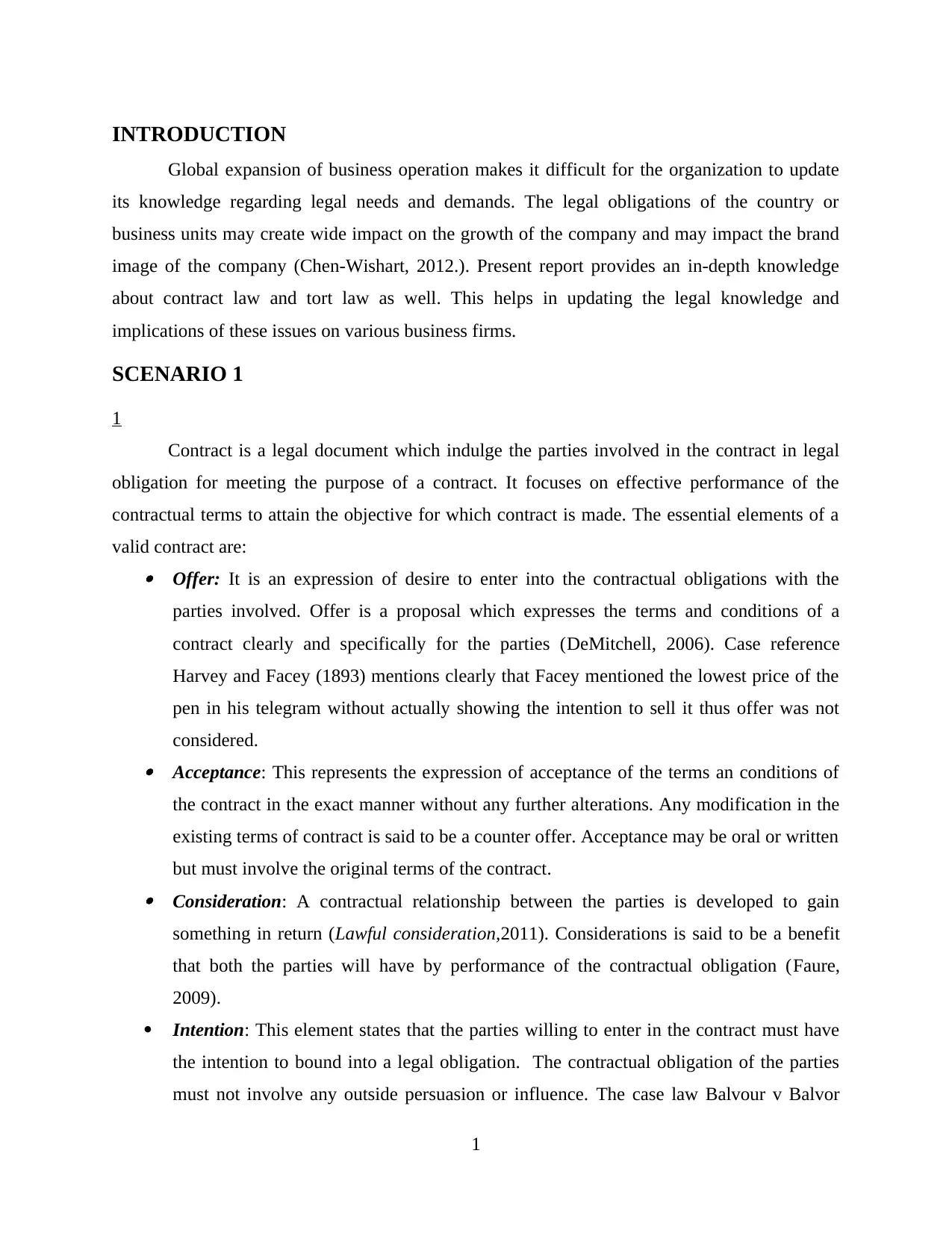
INTRODUCTION
Global expansion of business operation makes it difficult for the organization to update
its knowledge regarding legal needs and demands. The legal obligations of the country or
business units may create wide impact on the growth of the company and may impact the brand
image of the company (Chen-Wishart, 2012.). Present report provides an in-depth knowledge
about contract law and tort law as well. This helps in updating the legal knowledge and
implications of these issues on various business firms.
SCENARIO 1
1
Contract is a legal document which indulge the parties involved in the contract in legal
obligation for meeting the purpose of a contract. It focuses on effective performance of the
contractual terms to attain the objective for which contract is made. The essential elements of a
valid contract are: Offer: It is an expression of desire to enter into the contractual obligations with the
parties involved. Offer is a proposal which expresses the terms and conditions of a
contract clearly and specifically for the parties (DeMitchell, 2006). Case reference
Harvey and Facey (1893) mentions clearly that Facey mentioned the lowest price of the
pen in his telegram without actually showing the intention to sell it thus offer was not
considered. Acceptance: This represents the expression of acceptance of the terms an conditions of
the contract in the exact manner without any further alterations. Any modification in the
existing terms of contract is said to be a counter offer. Acceptance may be oral or written
but must involve the original terms of the contract. Consideration: A contractual relationship between the parties is developed to gain
something in return (Lawful consideration,2011). Considerations is said to be a benefit
that both the parties will have by performance of the contractual obligation (Faure,
2009).
Intention: This element states that the parties willing to enter in the contract must have
the intention to bound into a legal obligation. The contractual obligation of the parties
must not involve any outside persuasion or influence. The case law Balvour v Balvor
1
Global expansion of business operation makes it difficult for the organization to update
its knowledge regarding legal needs and demands. The legal obligations of the country or
business units may create wide impact on the growth of the company and may impact the brand
image of the company (Chen-Wishart, 2012.). Present report provides an in-depth knowledge
about contract law and tort law as well. This helps in updating the legal knowledge and
implications of these issues on various business firms.
SCENARIO 1
1
Contract is a legal document which indulge the parties involved in the contract in legal
obligation for meeting the purpose of a contract. It focuses on effective performance of the
contractual terms to attain the objective for which contract is made. The essential elements of a
valid contract are: Offer: It is an expression of desire to enter into the contractual obligations with the
parties involved. Offer is a proposal which expresses the terms and conditions of a
contract clearly and specifically for the parties (DeMitchell, 2006). Case reference
Harvey and Facey (1893) mentions clearly that Facey mentioned the lowest price of the
pen in his telegram without actually showing the intention to sell it thus offer was not
considered. Acceptance: This represents the expression of acceptance of the terms an conditions of
the contract in the exact manner without any further alterations. Any modification in the
existing terms of contract is said to be a counter offer. Acceptance may be oral or written
but must involve the original terms of the contract. Consideration: A contractual relationship between the parties is developed to gain
something in return (Lawful consideration,2011). Considerations is said to be a benefit
that both the parties will have by performance of the contractual obligation (Faure,
2009).
Intention: This element states that the parties willing to enter in the contract must have
the intention to bound into a legal obligation. The contractual obligation of the parties
must not involve any outside persuasion or influence. The case law Balvour v Balvor
1
⊘ This is a preview!⊘
Do you want full access?
Subscribe today to unlock all pages.

Trusted by 1+ million students worldwide
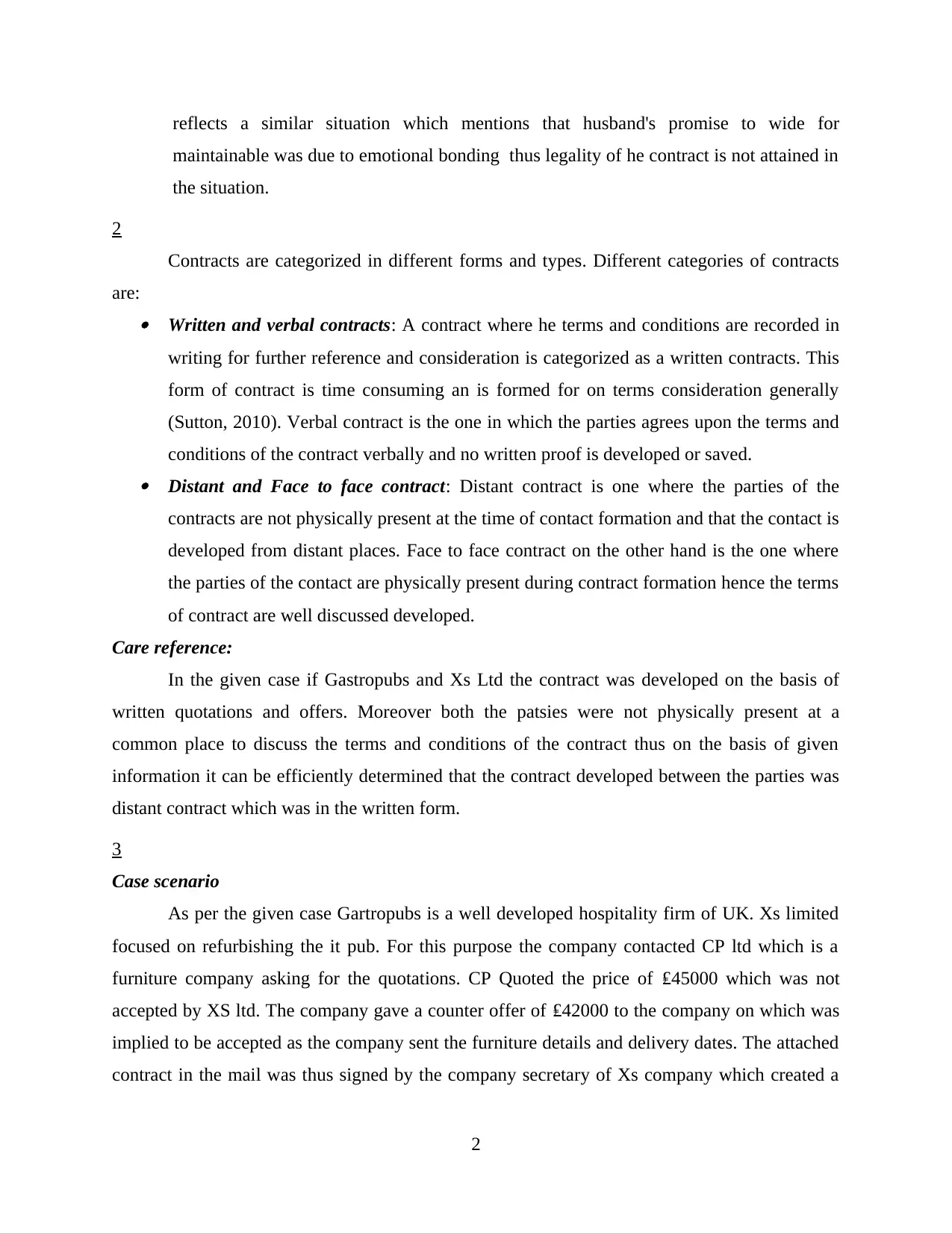
reflects a similar situation which mentions that husband's promise to wide for
maintainable was due to emotional bonding thus legality of he contract is not attained in
the situation.
2
Contracts are categorized in different forms and types. Different categories of contracts
are: Written and verbal contracts: A contract where he terms and conditions are recorded in
writing for further reference and consideration is categorized as a written contracts. This
form of contract is time consuming an is formed for on terms consideration generally
(Sutton, 2010). Verbal contract is the one in which the parties agrees upon the terms and
conditions of the contract verbally and no written proof is developed or saved. Distant and Face to face contract: Distant contract is one where the parties of the
contracts are not physically present at the time of contact formation and that the contact is
developed from distant places. Face to face contract on the other hand is the one where
the parties of the contact are physically present during contract formation hence the terms
of contract are well discussed developed.
Care reference:
In the given case if Gastropubs and Xs Ltd the contract was developed on the basis of
written quotations and offers. Moreover both the patsies were not physically present at a
common place to discuss the terms and conditions of the contract thus on the basis of given
information it can be efficiently determined that the contract developed between the parties was
distant contract which was in the written form.
3
Case scenario
As per the given case Gartropubs is a well developed hospitality firm of UK. Xs limited
focused on refurbishing the it pub. For this purpose the company contacted CP ltd which is a
furniture company asking for the quotations. CP Quoted the price of ₤45000 which was not
accepted by XS ltd. The company gave a counter offer of ₤42000 to the company on which was
implied to be accepted as the company sent the furniture details and delivery dates. The attached
contract in the mail was thus signed by the company secretary of Xs company which created a
2
maintainable was due to emotional bonding thus legality of he contract is not attained in
the situation.
2
Contracts are categorized in different forms and types. Different categories of contracts
are: Written and verbal contracts: A contract where he terms and conditions are recorded in
writing for further reference and consideration is categorized as a written contracts. This
form of contract is time consuming an is formed for on terms consideration generally
(Sutton, 2010). Verbal contract is the one in which the parties agrees upon the terms and
conditions of the contract verbally and no written proof is developed or saved. Distant and Face to face contract: Distant contract is one where the parties of the
contracts are not physically present at the time of contact formation and that the contact is
developed from distant places. Face to face contract on the other hand is the one where
the parties of the contact are physically present during contract formation hence the terms
of contract are well discussed developed.
Care reference:
In the given case if Gastropubs and Xs Ltd the contract was developed on the basis of
written quotations and offers. Moreover both the patsies were not physically present at a
common place to discuss the terms and conditions of the contract thus on the basis of given
information it can be efficiently determined that the contract developed between the parties was
distant contract which was in the written form.
3
Case scenario
As per the given case Gartropubs is a well developed hospitality firm of UK. Xs limited
focused on refurbishing the it pub. For this purpose the company contacted CP ltd which is a
furniture company asking for the quotations. CP Quoted the price of ₤45000 which was not
accepted by XS ltd. The company gave a counter offer of ₤42000 to the company on which was
implied to be accepted as the company sent the furniture details and delivery dates. The attached
contract in the mail was thus signed by the company secretary of Xs company which created a
2
Paraphrase This Document
Need a fresh take? Get an instant paraphrase of this document with our AI Paraphraser
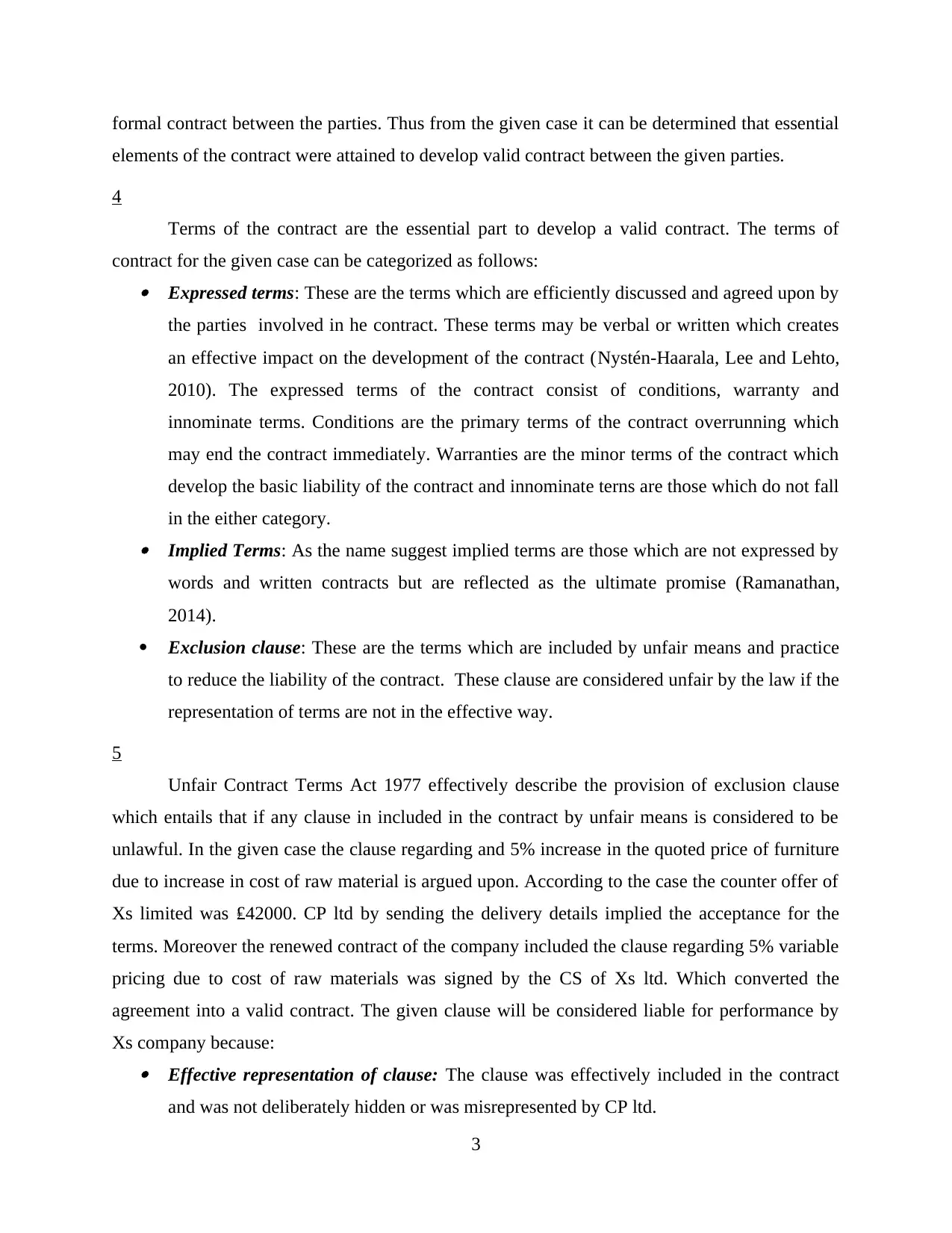
formal contract between the parties. Thus from the given case it can be determined that essential
elements of the contract were attained to develop valid contract between the given parties.
4
Terms of the contract are the essential part to develop a valid contract. The terms of
contract for the given case can be categorized as follows: Expressed terms: These are the terms which are efficiently discussed and agreed upon by
the parties involved in he contract. These terms may be verbal or written which creates
an effective impact on the development of the contract (Nystén-Haarala, Lee and Lehto,
2010). The expressed terms of the contract consist of conditions, warranty and
innominate terms. Conditions are the primary terms of the contract overrunning which
may end the contract immediately. Warranties are the minor terms of the contract which
develop the basic liability of the contract and innominate terns are those which do not fall
in the either category. Implied Terms: As the name suggest implied terms are those which are not expressed by
words and written contracts but are reflected as the ultimate promise (Ramanathan,
2014).
Exclusion clause: These are the terms which are included by unfair means and practice
to reduce the liability of the contract. These clause are considered unfair by the law if the
representation of terms are not in the effective way.
5
Unfair Contract Terms Act 1977 effectively describe the provision of exclusion clause
which entails that if any clause in included in the contract by unfair means is considered to be
unlawful. In the given case the clause regarding and 5% increase in the quoted price of furniture
due to increase in cost of raw material is argued upon. According to the case the counter offer of
Xs limited was ₤42000. CP ltd by sending the delivery details implied the acceptance for the
terms. Moreover the renewed contract of the company included the clause regarding 5% variable
pricing due to cost of raw materials was signed by the CS of Xs ltd. Which converted the
agreement into a valid contract. The given clause will be considered liable for performance by
Xs company because: Effective representation of clause: The clause was effectively included in the contract
and was not deliberately hidden or was misrepresented by CP ltd.
3
elements of the contract were attained to develop valid contract between the given parties.
4
Terms of the contract are the essential part to develop a valid contract. The terms of
contract for the given case can be categorized as follows: Expressed terms: These are the terms which are efficiently discussed and agreed upon by
the parties involved in he contract. These terms may be verbal or written which creates
an effective impact on the development of the contract (Nystén-Haarala, Lee and Lehto,
2010). The expressed terms of the contract consist of conditions, warranty and
innominate terms. Conditions are the primary terms of the contract overrunning which
may end the contract immediately. Warranties are the minor terms of the contract which
develop the basic liability of the contract and innominate terns are those which do not fall
in the either category. Implied Terms: As the name suggest implied terms are those which are not expressed by
words and written contracts but are reflected as the ultimate promise (Ramanathan,
2014).
Exclusion clause: These are the terms which are included by unfair means and practice
to reduce the liability of the contract. These clause are considered unfair by the law if the
representation of terms are not in the effective way.
5
Unfair Contract Terms Act 1977 effectively describe the provision of exclusion clause
which entails that if any clause in included in the contract by unfair means is considered to be
unlawful. In the given case the clause regarding and 5% increase in the quoted price of furniture
due to increase in cost of raw material is argued upon. According to the case the counter offer of
Xs limited was ₤42000. CP ltd by sending the delivery details implied the acceptance for the
terms. Moreover the renewed contract of the company included the clause regarding 5% variable
pricing due to cost of raw materials was signed by the CS of Xs ltd. Which converted the
agreement into a valid contract. The given clause will be considered liable for performance by
Xs company because: Effective representation of clause: The clause was effectively included in the contract
and was not deliberately hidden or was misrepresented by CP ltd.
3
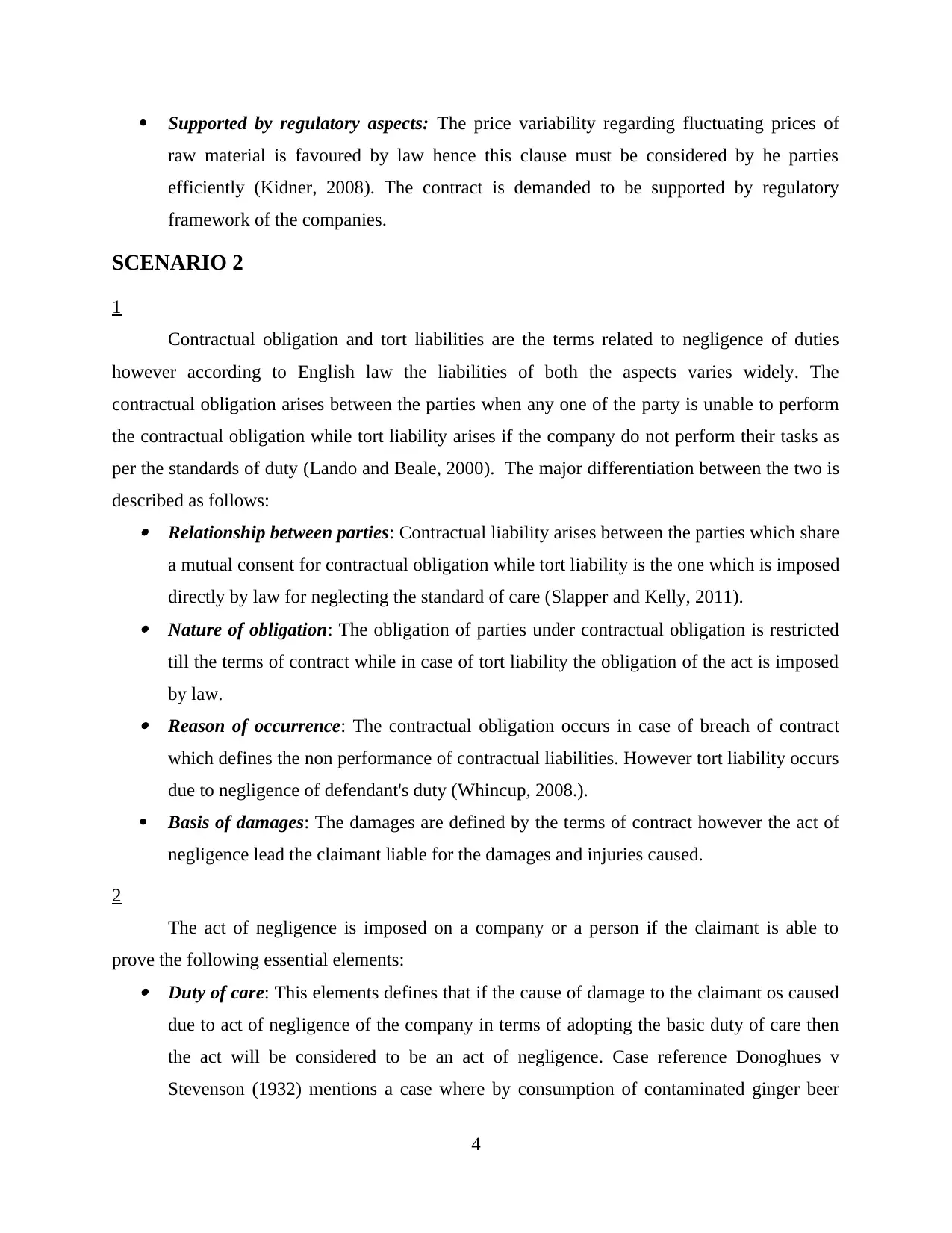
Supported by regulatory aspects: The price variability regarding fluctuating prices of
raw material is favoured by law hence this clause must be considered by he parties
efficiently (Kidner, 2008). The contract is demanded to be supported by regulatory
framework of the companies.
SCENARIO 2
1
Contractual obligation and tort liabilities are the terms related to negligence of duties
however according to English law the liabilities of both the aspects varies widely. The
contractual obligation arises between the parties when any one of the party is unable to perform
the contractual obligation while tort liability arises if the company do not perform their tasks as
per the standards of duty (Lando and Beale, 2000). The major differentiation between the two is
described as follows: Relationship between parties: Contractual liability arises between the parties which share
a mutual consent for contractual obligation while tort liability is the one which is imposed
directly by law for neglecting the standard of care (Slapper and Kelly, 2011). Nature of obligation: The obligation of parties under contractual obligation is restricted
till the terms of contract while in case of tort liability the obligation of the act is imposed
by law. Reason of occurrence: The contractual obligation occurs in case of breach of contract
which defines the non performance of contractual liabilities. However tort liability occurs
due to negligence of defendant's duty (Whincup, 2008.).
Basis of damages: The damages are defined by the terms of contract however the act of
negligence lead the claimant liable for the damages and injuries caused.
2
The act of negligence is imposed on a company or a person if the claimant is able to
prove the following essential elements: Duty of care: This elements defines that if the cause of damage to the claimant os caused
due to act of negligence of the company in terms of adopting the basic duty of care then
the act will be considered to be an act of negligence. Case reference Donoghues v
Stevenson (1932) mentions a case where by consumption of contaminated ginger beer
4
raw material is favoured by law hence this clause must be considered by he parties
efficiently (Kidner, 2008). The contract is demanded to be supported by regulatory
framework of the companies.
SCENARIO 2
1
Contractual obligation and tort liabilities are the terms related to negligence of duties
however according to English law the liabilities of both the aspects varies widely. The
contractual obligation arises between the parties when any one of the party is unable to perform
the contractual obligation while tort liability arises if the company do not perform their tasks as
per the standards of duty (Lando and Beale, 2000). The major differentiation between the two is
described as follows: Relationship between parties: Contractual liability arises between the parties which share
a mutual consent for contractual obligation while tort liability is the one which is imposed
directly by law for neglecting the standard of care (Slapper and Kelly, 2011). Nature of obligation: The obligation of parties under contractual obligation is restricted
till the terms of contract while in case of tort liability the obligation of the act is imposed
by law. Reason of occurrence: The contractual obligation occurs in case of breach of contract
which defines the non performance of contractual liabilities. However tort liability occurs
due to negligence of defendant's duty (Whincup, 2008.).
Basis of damages: The damages are defined by the terms of contract however the act of
negligence lead the claimant liable for the damages and injuries caused.
2
The act of negligence is imposed on a company or a person if the claimant is able to
prove the following essential elements: Duty of care: This elements defines that if the cause of damage to the claimant os caused
due to act of negligence of the company in terms of adopting the basic duty of care then
the act will be considered to be an act of negligence. Case reference Donoghues v
Stevenson (1932) mentions a case where by consumption of contaminated ginger beer
4
⊘ This is a preview!⊘
Do you want full access?
Subscribe today to unlock all pages.

Trusted by 1+ million students worldwide
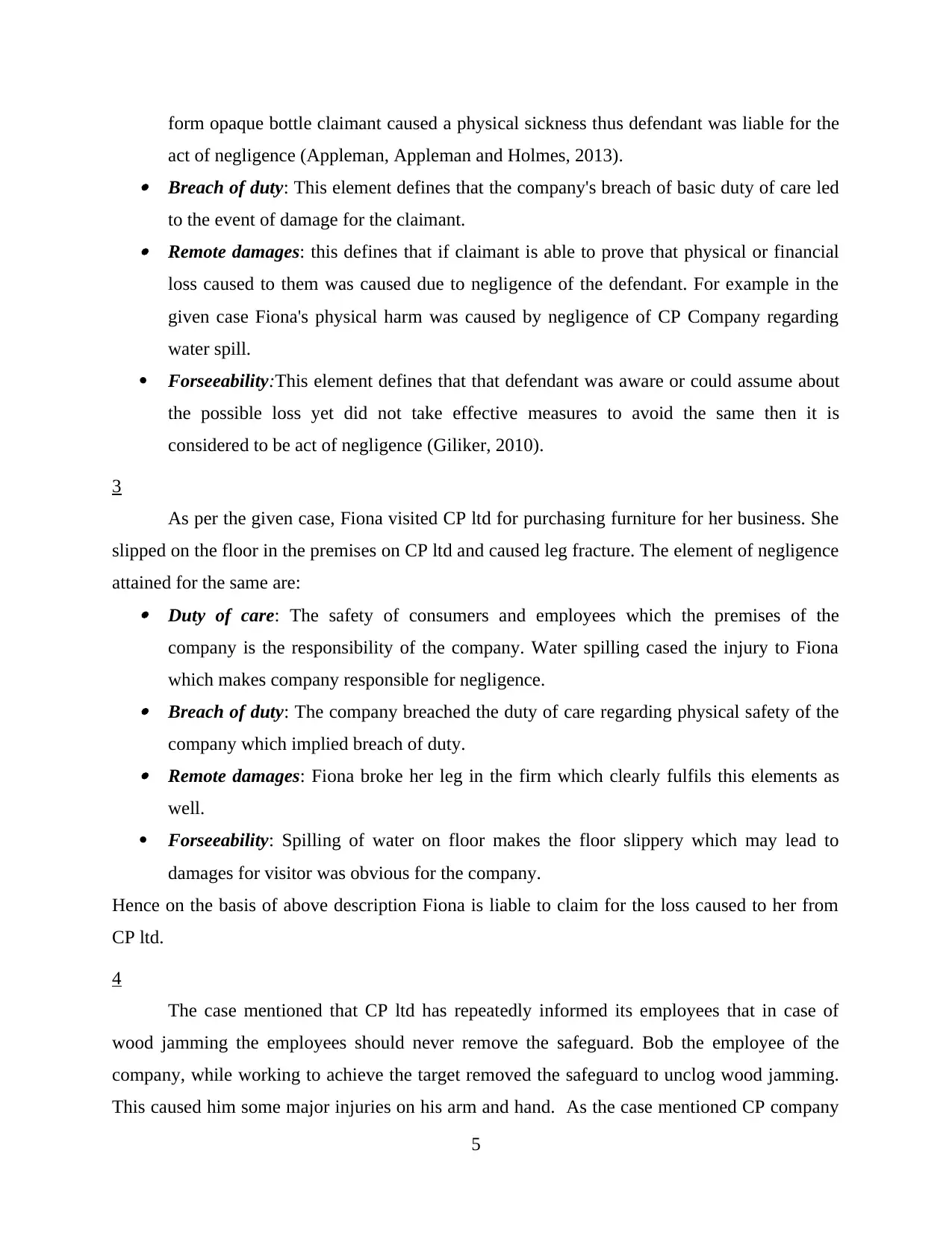
form opaque bottle claimant caused a physical sickness thus defendant was liable for the
act of negligence (Appleman, Appleman and Holmes, 2013). Breach of duty: This element defines that the company's breach of basic duty of care led
to the event of damage for the claimant. Remote damages: this defines that if claimant is able to prove that physical or financial
loss caused to them was caused due to negligence of the defendant. For example in the
given case Fiona's physical harm was caused by negligence of CP Company regarding
water spill.
Forseeability:This element defines that that defendant was aware or could assume about
the possible loss yet did not take effective measures to avoid the same then it is
considered to be act of negligence (Giliker, 2010).
3
As per the given case, Fiona visited CP ltd for purchasing furniture for her business. She
slipped on the floor in the premises on CP ltd and caused leg fracture. The element of negligence
attained for the same are: Duty of care: The safety of consumers and employees which the premises of the
company is the responsibility of the company. Water spilling cased the injury to Fiona
which makes company responsible for negligence. Breach of duty: The company breached the duty of care regarding physical safety of the
company which implied breach of duty. Remote damages: Fiona broke her leg in the firm which clearly fulfils this elements as
well.
Forseeability: Spilling of water on floor makes the floor slippery which may lead to
damages for visitor was obvious for the company.
Hence on the basis of above description Fiona is liable to claim for the loss caused to her from
CP ltd.
4
The case mentioned that CP ltd has repeatedly informed its employees that in case of
wood jamming the employees should never remove the safeguard. Bob the employee of the
company, while working to achieve the target removed the safeguard to unclog wood jamming.
This caused him some major injuries on his arm and hand. As the case mentioned CP company
5
act of negligence (Appleman, Appleman and Holmes, 2013). Breach of duty: This element defines that the company's breach of basic duty of care led
to the event of damage for the claimant. Remote damages: this defines that if claimant is able to prove that physical or financial
loss caused to them was caused due to negligence of the defendant. For example in the
given case Fiona's physical harm was caused by negligence of CP Company regarding
water spill.
Forseeability:This element defines that that defendant was aware or could assume about
the possible loss yet did not take effective measures to avoid the same then it is
considered to be act of negligence (Giliker, 2010).
3
As per the given case, Fiona visited CP ltd for purchasing furniture for her business. She
slipped on the floor in the premises on CP ltd and caused leg fracture. The element of negligence
attained for the same are: Duty of care: The safety of consumers and employees which the premises of the
company is the responsibility of the company. Water spilling cased the injury to Fiona
which makes company responsible for negligence. Breach of duty: The company breached the duty of care regarding physical safety of the
company which implied breach of duty. Remote damages: Fiona broke her leg in the firm which clearly fulfils this elements as
well.
Forseeability: Spilling of water on floor makes the floor slippery which may lead to
damages for visitor was obvious for the company.
Hence on the basis of above description Fiona is liable to claim for the loss caused to her from
CP ltd.
4
The case mentioned that CP ltd has repeatedly informed its employees that in case of
wood jamming the employees should never remove the safeguard. Bob the employee of the
company, while working to achieve the target removed the safeguard to unclog wood jamming.
This caused him some major injuries on his arm and hand. As the case mentioned CP company
5
Paraphrase This Document
Need a fresh take? Get an instant paraphrase of this document with our AI Paraphraser
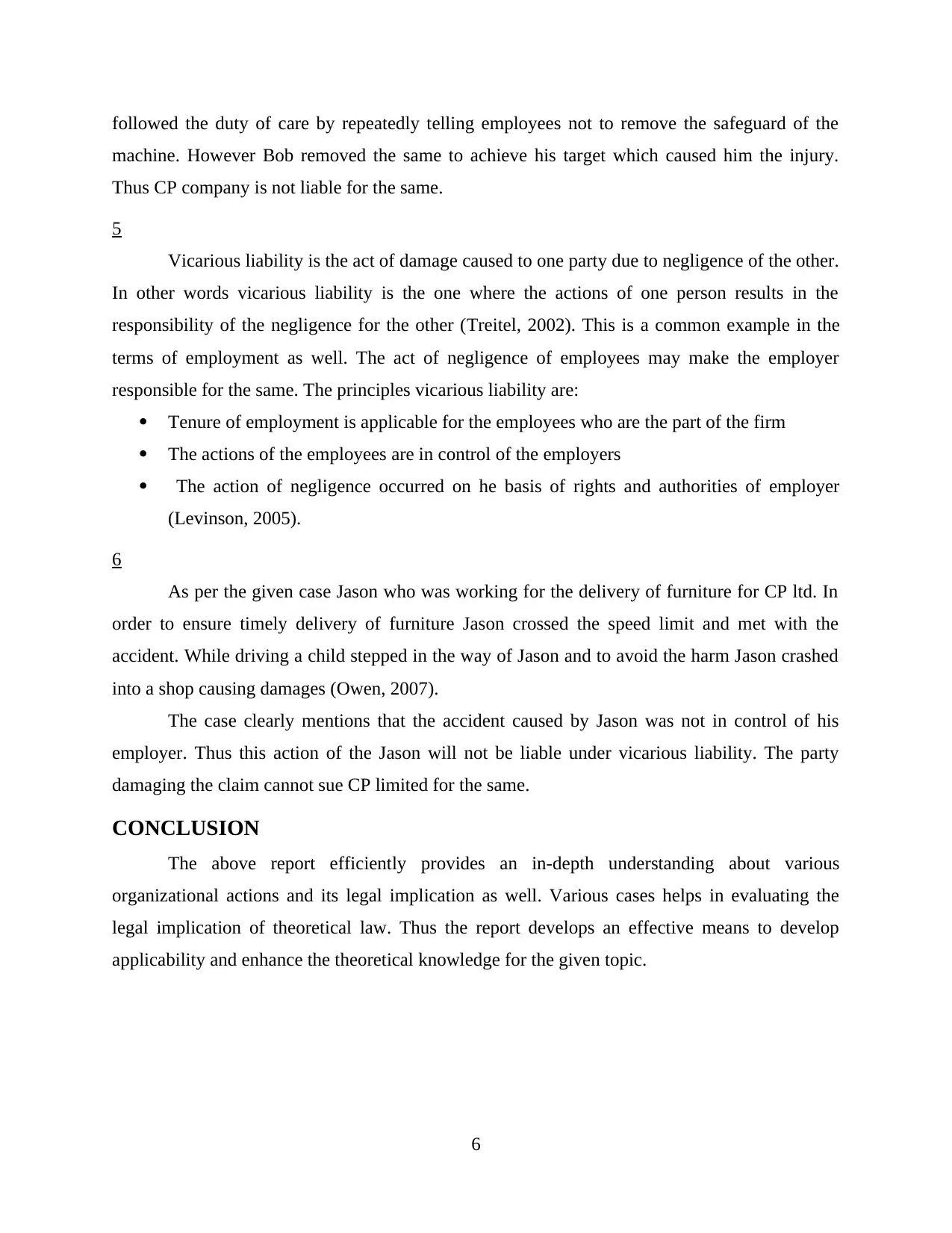
followed the duty of care by repeatedly telling employees not to remove the safeguard of the
machine. However Bob removed the same to achieve his target which caused him the injury.
Thus CP company is not liable for the same.
5
Vicarious liability is the act of damage caused to one party due to negligence of the other.
In other words vicarious liability is the one where the actions of one person results in the
responsibility of the negligence for the other (Treitel, 2002). This is a common example in the
terms of employment as well. The act of negligence of employees may make the employer
responsible for the same. The principles vicarious liability are:
Tenure of employment is applicable for the employees who are the part of the firm
The actions of the employees are in control of the employers
The action of negligence occurred on he basis of rights and authorities of employer
(Levinson, 2005).
6
As per the given case Jason who was working for the delivery of furniture for CP ltd. In
order to ensure timely delivery of furniture Jason crossed the speed limit and met with the
accident. While driving a child stepped in the way of Jason and to avoid the harm Jason crashed
into a shop causing damages (Owen, 2007).
The case clearly mentions that the accident caused by Jason was not in control of his
employer. Thus this action of the Jason will not be liable under vicarious liability. The party
damaging the claim cannot sue CP limited for the same.
CONCLUSION
The above report efficiently provides an in-depth understanding about various
organizational actions and its legal implication as well. Various cases helps in evaluating the
legal implication of theoretical law. Thus the report develops an effective means to develop
applicability and enhance the theoretical knowledge for the given topic.
6
machine. However Bob removed the same to achieve his target which caused him the injury.
Thus CP company is not liable for the same.
5
Vicarious liability is the act of damage caused to one party due to negligence of the other.
In other words vicarious liability is the one where the actions of one person results in the
responsibility of the negligence for the other (Treitel, 2002). This is a common example in the
terms of employment as well. The act of negligence of employees may make the employer
responsible for the same. The principles vicarious liability are:
Tenure of employment is applicable for the employees who are the part of the firm
The actions of the employees are in control of the employers
The action of negligence occurred on he basis of rights and authorities of employer
(Levinson, 2005).
6
As per the given case Jason who was working for the delivery of furniture for CP ltd. In
order to ensure timely delivery of furniture Jason crossed the speed limit and met with the
accident. While driving a child stepped in the way of Jason and to avoid the harm Jason crashed
into a shop causing damages (Owen, 2007).
The case clearly mentions that the accident caused by Jason was not in control of his
employer. Thus this action of the Jason will not be liable under vicarious liability. The party
damaging the claim cannot sue CP limited for the same.
CONCLUSION
The above report efficiently provides an in-depth understanding about various
organizational actions and its legal implication as well. Various cases helps in evaluating the
legal implication of theoretical law. Thus the report develops an effective means to develop
applicability and enhance the theoretical knowledge for the given topic.
6

7
⊘ This is a preview!⊘
Do you want full access?
Subscribe today to unlock all pages.

Trusted by 1+ million students worldwide
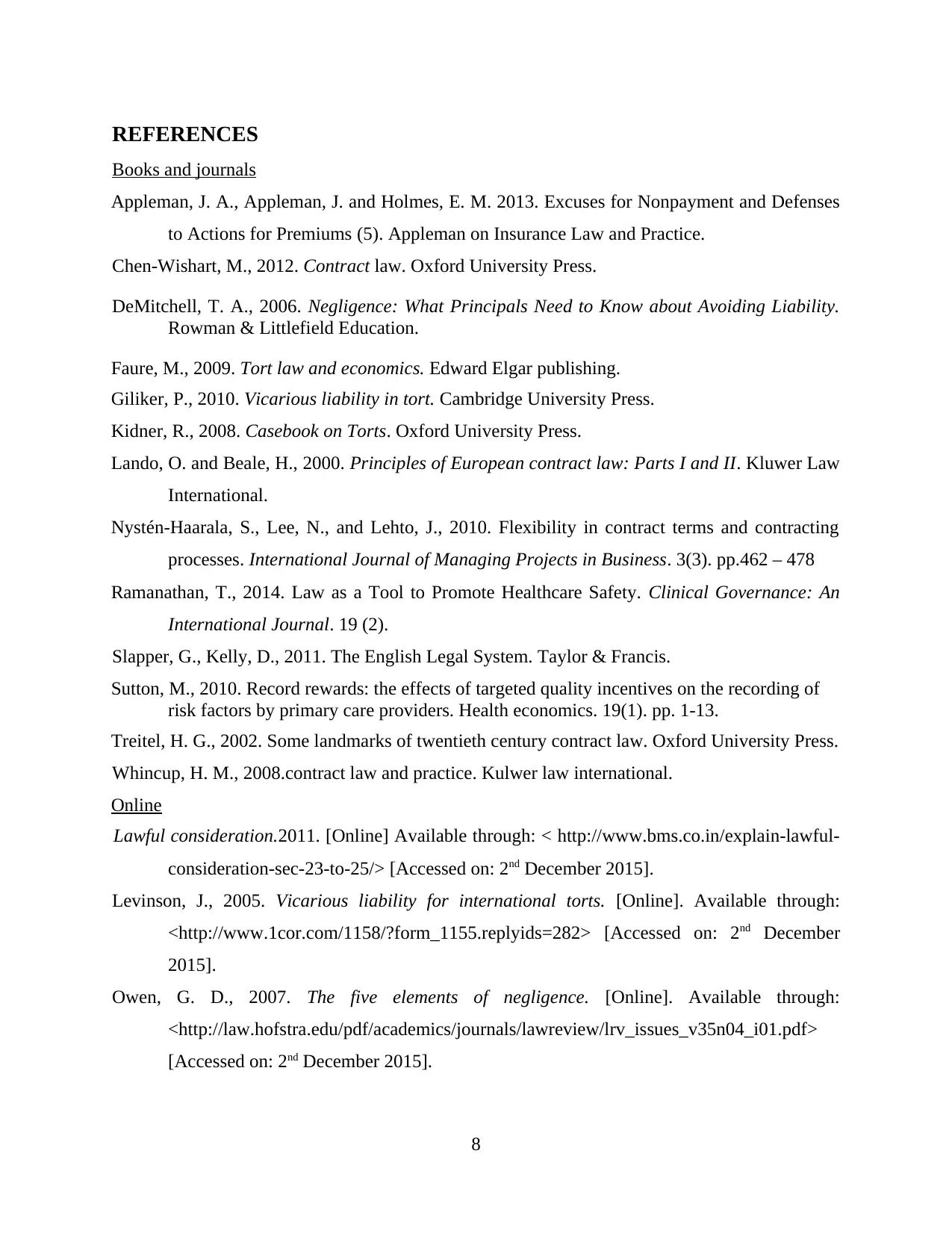
REFERENCES
Books and journals
Appleman, J. A., Appleman, J. and Holmes, E. M. 2013. Excuses for Nonpayment and Defenses
to Actions for Premiums (5). Appleman on Insurance Law and Practice.
Chen-Wishart, M., 2012. Contract law. Oxford University Press.
DeMitchell, T. A., 2006. Negligence: What Principals Need to Know about Avoiding Liability.
Rowman & Littlefield Education.
Faure, M., 2009. Tort law and economics. Edward Elgar publishing.
Giliker, P., 2010. Vicarious liability in tort. Cambridge University Press.
Kidner, R., 2008. Casebook on Torts. Oxford University Press.
Lando, O. and Beale, H., 2000. Principles of European contract law: Parts I and II. Kluwer Law
International.
Nystén-Haarala, S., Lee, N., and Lehto, J., 2010. Flexibility in contract terms and contracting
processes. International Journal of Managing Projects in Business. 3(3). pp.462 – 478
Ramanathan, T., 2014. Law as a Tool to Promote Healthcare Safety. Clinical Governance: An
International Journal. 19 (2).
Slapper, G., Kelly, D., 2011. The English Legal System. Taylor & Francis.
Sutton, M., 2010. Record rewards: the effects of targeted quality incentives on the recording of
risk factors by primary care providers. Health economics. 19(1). pp. 1-13.
Treitel, H. G., 2002. Some landmarks of twentieth century contract law. Oxford University Press.
Whincup, H. M., 2008.contract law and practice. Kulwer law international.
Online
Lawful consideration.2011. [Online] Available through: < http://www.bms.co.in/explain-lawful-
consideration-sec-23-to-25/> [Accessed on: 2nd December 2015].
Levinson, J., 2005. Vicarious liability for international torts. [Online]. Available through:
<http://www.1cor.com/1158/?form_1155.replyids=282> [Accessed on: 2nd December
2015].
Owen, G. D., 2007. The five elements of negligence. [Online]. Available through:
<http://law.hofstra.edu/pdf/academics/journals/lawreview/lrv_issues_v35n04_i01.pdf>
[Accessed on: 2nd December 2015].
8
Books and journals
Appleman, J. A., Appleman, J. and Holmes, E. M. 2013. Excuses for Nonpayment and Defenses
to Actions for Premiums (5). Appleman on Insurance Law and Practice.
Chen-Wishart, M., 2012. Contract law. Oxford University Press.
DeMitchell, T. A., 2006. Negligence: What Principals Need to Know about Avoiding Liability.
Rowman & Littlefield Education.
Faure, M., 2009. Tort law and economics. Edward Elgar publishing.
Giliker, P., 2010. Vicarious liability in tort. Cambridge University Press.
Kidner, R., 2008. Casebook on Torts. Oxford University Press.
Lando, O. and Beale, H., 2000. Principles of European contract law: Parts I and II. Kluwer Law
International.
Nystén-Haarala, S., Lee, N., and Lehto, J., 2010. Flexibility in contract terms and contracting
processes. International Journal of Managing Projects in Business. 3(3). pp.462 – 478
Ramanathan, T., 2014. Law as a Tool to Promote Healthcare Safety. Clinical Governance: An
International Journal. 19 (2).
Slapper, G., Kelly, D., 2011. The English Legal System. Taylor & Francis.
Sutton, M., 2010. Record rewards: the effects of targeted quality incentives on the recording of
risk factors by primary care providers. Health economics. 19(1). pp. 1-13.
Treitel, H. G., 2002. Some landmarks of twentieth century contract law. Oxford University Press.
Whincup, H. M., 2008.contract law and practice. Kulwer law international.
Online
Lawful consideration.2011. [Online] Available through: < http://www.bms.co.in/explain-lawful-
consideration-sec-23-to-25/> [Accessed on: 2nd December 2015].
Levinson, J., 2005. Vicarious liability for international torts. [Online]. Available through:
<http://www.1cor.com/1158/?form_1155.replyids=282> [Accessed on: 2nd December
2015].
Owen, G. D., 2007. The five elements of negligence. [Online]. Available through:
<http://law.hofstra.edu/pdf/academics/journals/lawreview/lrv_issues_v35n04_i01.pdf>
[Accessed on: 2nd December 2015].
8
1 out of 10
Related Documents
Your All-in-One AI-Powered Toolkit for Academic Success.
+13062052269
info@desklib.com
Available 24*7 on WhatsApp / Email
![[object Object]](/_next/static/media/star-bottom.7253800d.svg)
Unlock your academic potential
Copyright © 2020–2025 A2Z Services. All Rights Reserved. Developed and managed by ZUCOL.





